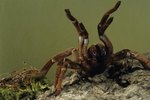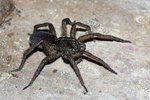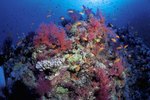
Sea spiders, or pycnogonids, have tiny abdomens, four or more pairs of walking legs and a proboscis that helps them eat. More than 1,000 species live throughout the world in oceans ranging from tropical to arctic. Sea spiders measure less than 1/10 inch to more than 2 feet across, and can survive in depths up to 23,000 feet. Scientists don’t yet know how long these fascinating creatures live.
Mating
Sea spiders rely on their legs for reproduction. The female keeps unfertilized eggs in her femurs until she’s ready to mate. Then the male uses his ovigers -- special legs located between the claws and the walking legs -- to stimulate her into laying eggs. She releases them through an opening called a gonopore, located at the junction of the leg and body. The male fertilizes the eggs either from above or below her body.
Incubation
After fertilization, the male collects the eggs and secretes a substance that attaches them to his ovigers. He carries them with him until they hatch, although scientists don’t know how long this takes, according to Dr. Bonnie A. Bain's All About Sea Spiders site. In a few species, juveniles remain on the father’s ovigers until they’re large enough to survive on their own.
Larvae
Most young sea spiders hatch as larvae, although a few emerge in their adult form. Pycnogonids born as larvae have to go through several molts to develop their legs. Depending on the species, they either do this while swimming to find prey, eventually landing on the ocean floor; attach themselves to coral or mollusks until they’ve reached adulthood; or remain on the father’s ovigers until they’re able to walk. Again, scientists aren't sure how long this process takes.
Feeding
As a group, sea spiders are omnivorous, with different species preferring algae, scavenged material or meat. They have three small teeth in their proboscis, which the carnivores use to puncture prey such as anemones, corals, jellyfish, marine worms, nudibranchs and other invertebrates. Then they use the proboscis to suck juices and fluids from the prey.
References
- All About Sea Spiders; Pycnogonid Courtship, Mating Behavior, and Parental Care; Bonnie Bain
- All About Sea Spiders; Pycnogonid Post-Embryonic Development; Bonnie Bain
- Animal Diversity Web: Pycnogonida
- University of California Museum of Paleontology: Introduction to the Pycnogonida
- All About Sea Spiders; Pycnogonid Morphology; Bonnie Bain
- BioDiversity Explorer: Class: Pycnogonida (Sea Spiders)
Photo Credits
-
Jupiterimages/Photos.com/Getty Images



